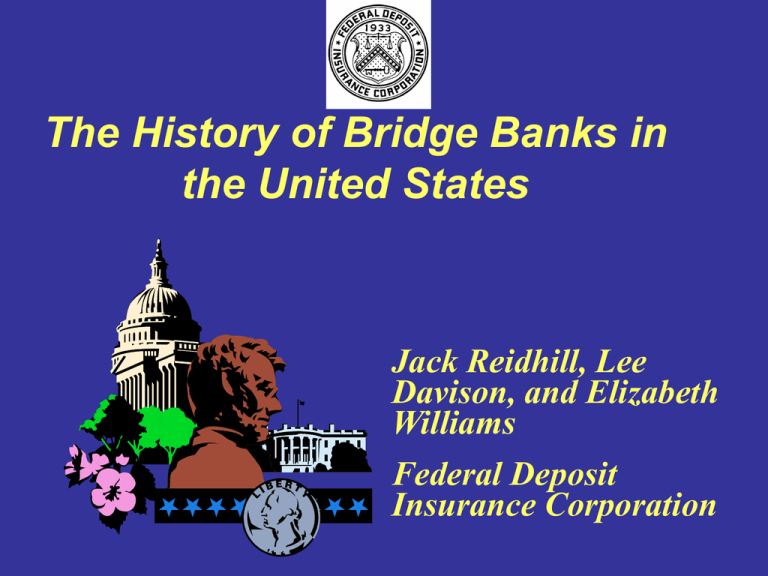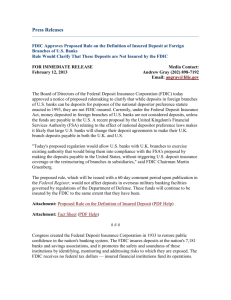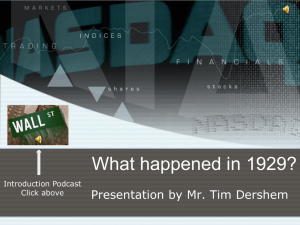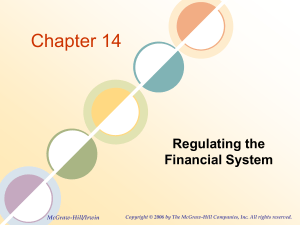Bridge banks - the US experience
advertisement

The History of Bridge Banks in the United States Jack Reidhill, Lee Davison, and Elizabeth Williams Federal Deposit Insurance Corporation Introduction • FDIC bridge bank authority was a result of the 1980s banking crisis. • This authority has been used only ten times, the last time was in 1994. • Prior to the crisis, failure resolution was generally a simple process, using either a purchase and assumption transaction or a deposit payout. • Despite the banking crisis, it took until 1987 for the FDIC to have the flexibility to take over a bank and run it until a viable resolution strategy was developed. Presentation Outline • The FDIC’s use of Deposit Insurance National Banks before it was granted bridge bank authority. • The difficulties of using open bank assistance to resolve large complex banks. • How the FDIC’s use of bridge banks changed from 1988 to 1994. • Lessons from the FDIC’s experience. An Early Precursor: Deposit Insurance National Banks • The Banking Act of 1933 did not give the FDIC authority to pay insured depositors directly. • Instead, depositors were paid through a newly chartered national bank. • These were called Deposit Insurance National Banks (DINBs). • Between 1933–1935, 24 depositor payoffs were made through DINBs. Deposit Insurance National Bank 1933-1935 Failed Bank Receivership Retained most assets, all uninsured deposits, other claimants, Subrogated insured deposit claim (FDIC) Collected on assets DINB Assumed all insured deposits, Bank building, and contents Paid out deposits The Commercial National Bank of Bradford Failed in 1935 Receivership Retained most assets, all uninsured deposits, other claimants, subrogated insured deposit claim (FDIC) DINB Assumed all insured deposits, bank building, and contents 1936, Citizens National Bank of Bradford formed– Purchased bank building, and contents Later Use of DINBs • The 1935 Banking Act gave the FDIC direct payoff authority. • DINBs were not used again until the 1960s. • In 1964, two DINBs were created after bank failures in Texas and Virginia. • A new bank was formed to succeed the Virginia DINB. • Two DINBs were created in 1975 in Missouri and Puerto Rico, but no successor banks were formed. Crown Savings Bank Failed in 1964 Receivership Retained most assets, all uninsured deposits, other claimants, Subrogated insured deposit claim (FDIC) DINB Assumed all insured deposits, bank building, and contents Bank of Newport formed 2 years later-Purchased the remaining assets of Receivership, assumed the remaining deposit liabilities of the DINB The Last Use of the DINB: Penn Square • Failed in 1982 with $263 million in uninsured deposits and $207 million in insured deposits. • Other regulators urged the FDIC to use a P&A or provide open bank assistance. • The FDIC favored a payoff as no other cost-effective way was available to limit losses to the insurance fund. • At the time, this was the largest payoff in FDIC history: the agency decided a DINB would be the best method to pay so many claims. • The DINB worked well, paying out all but $10 million within 2 months. Continental Illinois’ 1984 Failure Shows Need for Bridge Banks • Regulators provided liquidity assistance and made a controversial promise to protect all the bank’s creditors. • Continental’s complexity, state branching restrictions, litigation risk, and uncertainty about its assets prevented the FDIC from finding an acquirer. • Regulators used a very complex open bank assistance package that required negotiations with stockholders. Continental Illinois’ 1984 Failure Shows Need for Bridge Banks, cont. • The FDIC covered losses, took control of the bank, provided capital, and named management. • The FDIC received junior perpetual preferred stock, adjustable-rate preferred stock, and stock warrants. • The FDIC began selling its shares in 1986; return to private sector was completed in 1991, 7 years after the resolution. Lessons from Continental • Lack of bridge bank authority caused unnecessary complications and delayed resolution. • The blanket guarantee that protected all creditors would have been unnecessary. • A bridge could have cut off stockholders from the bank, eliminating the need for negotiation. Lessons from Continental, cont. • A bridge would have made the complex open bank assistance agreement unnecessary. • Still likely, however, that all non–holding company creditors would have been protected. Attempts to Provide Flexibility: Mid1980s Legislation • In 1983 the FDIC sought legislative changes to its DINB authority that would have allowed a DINB to function as a bridge bank. • Similar legislation was introduced in 1984 and 1985. • In 1986, the FDIC first sought separate bridge bank authority. • Finally, in 1987, Congress provided bridge bank authority within the Competitive Equality Banking Act. Bridge Bank Authority under CEBA • The FDIC determined if a bridge bank was “in the interest of the depositors of the closed bank and the public.” • Any number of banks could be placed in a single bridge bank. • The FDIC had discretion about which assets and liabilities were placed in the bridge bank. • The bridge bank was allowed to operate without capital; any restrictions based on capital were waived. Bridge Bank Authority (continued) • The FDIC could appoint a board of directors, who were to elect a chairman and appoint the CEO. • The FDIC could provide operating funds to the bank. • The bridge would be terminated upon completion of a P&A or sale of controlling stock. • Only banks with $500 million could be sold to out-ofstate bidders unless authorized by state law. • The bridge bank’s life was limited to 2 years, with a 1-year extension possible, this was modified in 1989 to a 2 year limit with three 1-year extensions. Bridge Bank Authority (continued) • Although the bridge has a limited life, there is no restriction on how long the FDIC can maintain their stock position. • By law, the FDIC is not allowed to acquire voting shares (common stock, or other types of voting stock) through an assisted transaction. • The FDIC is allowed to acquire convertible preferred, warrants, and debt. • The FDIC can attach bond like covenants to these instruments that can result in the FDIC effectively controlling the actions of the bank. FDIC Use of Bridge Banks: First Republic • A $33 billion Texas organization formed through merger in 1987; a bank run forced it to ask for FDIC assistance in March 1988. • The FDIC adopted an interim assistance package that did not create a bridge bank. • The FDIC provided a $1 billion loan guaranteed by the holding company and collateralized by the stock of its subsidiary banks. • The assistance package specifically excluded holding company and interbank creditors. • The FDIC marketed the bank and accepted a bid from NCNB on July 28. First Republic (Continued) • On July 29, the FDIC’s notification that it would not renew the loan caused the OCC to declare the Dallas subsidiary bank insolvent. • This ultimately led the other 40 subsidiaries to be declared insolvent. The FDIC was appointed receiver. • The FDIC created a bridge bank, which purchased all the failed banks’ assets, assumed all deposits and certain other liabilities. • This effectively severed the banks from the BHC debt holders and stockholders First Republic (Continued) • The FDIC then contracted with NCNB to manage the bank pending a final agreement. • A final agreement was signed in November 1988. • The FDIC converted the bridge bank to a stock form. • NCNB bought 20% of shares. The FDIC bought 80% non-voting Class B common stock. • NCNB given 5-year option to purchase FDIC’s shares. • All the bad assets remained with the new bank, with NCNB managing their liquidation and the FDIC paying for any losses. First Republic failed in 1988 1 credit card subsidiary in Delaware Receivership Becomes bridge bank 40 subsidiary banks 40 Receiverships Bridge bank formed from 40 receiverships and acquired by NCNB Texas National Bank Issued stock Sold to Citibank Was purchased by NCNB and FDIC Converted to NCNB Texas Bankcorporation Lessons from First Republic • There are two possible reasons why the FDIC didn’t immediately turn to a bridge bank. – The authority was new—the FDIC was not used to employing it as a first step. – Some of the subsidiaries might have remained solvent and outside FDIC control without the interim assistance and collateral guarantee. Lessons from First Republic, cont. • Overall, using bridge bank authority proved much more efficient than open bank assistance. • Uninsured bank creditors were still made whole, but BHC creditors were not. MCorp’s 1989 Failure • MCorp ($18 billion at failure) sought open bank assistance but was rejected. • BHC creditors filed bankruptcy petition, forcing lead bank and 5 affiliates into insolvency. • Their insolvency brought down 14 other affiliates. Five affiliates remained solvent and under the BHC’s control. MCorp’s 1989 Failure, cont. • The FDIC formed a bridge bank. For 19 of the banks, the FDIC passed all assets and the unsubordinated creditors and depositors to the bridge. • Only insured depositors of the 20th bank were covered, as the bank had large outstanding judgments. • The FDIC solicited bids and, in a transaction similar to First Republic, picked a winner 3 months later. Lessons from MCorp • If possible, it is efficient to create a bridge bank at the beginning of the resolution process. • The BHC structure allowed MCorp to keep solvent affiliates and sell them for the benefit of the BHC rather than their being available to shield the FDIC from losses. • This situation caused the FDIC to request cross guarantee authority be included in a statute (FIRREA) passed later in 1989. Bank of New England’s (BNE) 1991 Failure • When 2 of 3 affiliates failed, a third solvent bank was seized using the FDIC’s new crossguarantee authority. All 3 banks were immediately placed in a bridge bank. • The FDIC, as usual, protected uninsured depositors and creditors. • This led to considerable criticism about disparate treatment of large and small banks. • These criticisms may have played a role in the provisions in FDICIA (passed later in 1991) that restricted the FDIC’s ability to protect uninsured depositors and creditors. First City’s 1992 Failure • Last use of a large bank bridge. First time under FDICIA least-cost restrictions. • 2 lead banks declared insolvent in October 1992; FDIC invoked cross guarantees, rendering the 18 affiliates insolvent. • FDIC created 20 individual bridge banks and prepared cost test for each (liquidation vs. operation and resolution of bridge). • In 16 banks, all deposits were passed to the bridge bank. In 4 banks, less costly to pass only insured deposits to the bridge bank. First City’s 1992 Failure, cont. • In a unique resolution, the FDIC marketed the 20 banks for sale individually or as any group, accepting the best set of bids. – 13 of the banks were sold without assistance – With improvement in the Texas economy, all uninsured bank creditors, bondholders and depositors eventually made whole. Even stockholders received some funds. First City failed in 1992 20 subsidiary banks 20 receiverships 20 bridge banks created 16 banks, all deposits transferred 4 banks, only insured were transferred 20 bridge banks are sold to 12 different financial institutions Number that each institution acquired 1 acquired 5 5 acquired 2 6 acquired 1 Lessons from First City • Demonstrated that the FDIC’s use of resolution strategies (bridge bank and cross-guarantee) had matured. • The failed banks were closed and promptly put into bridge banks. • The least cost test helped the FDIC innovate in its use of bridge banks. • The resolution structure yielded maximum bids and a low-cost resolution. Review of Bridge Bank Authority • Bridge bank authority was created by the Competitive Equality Banking Act of 1987. • A bridge bank is a resolution strategy in which a temporary bank is established in the case of failure. • A de novo national bank is chartered by the Comptroller of the Currency and is controlled by the FDIC. • The bank is designed to “bridge” the time between failure and when the FDIC can effect an acquisition. • The charter is issued with an initial 2-year term; up to three 1-year extensions are possible. Conclusions • The FDIC’s use of bridge banks evolved significantly from 1987 to 1994. • The FDIC has found that early bridge formation shortens resolution. • Bridge banks help maintain bank operations while a final resolution is constructed. • Additional tools, like cross guarantees may be necessary to reduce costs when failures involve BHCs with many subsidiary or affiliate banks. • Resolution of bridge banks can be made to operate efficiently within FDICIA’s least cost test. • Bridge bank authority can be adapted both to periods when lengthy resolutions are anticipated (1987–1991) and to periods when conditions are improving (e.g. First City in 1992).



